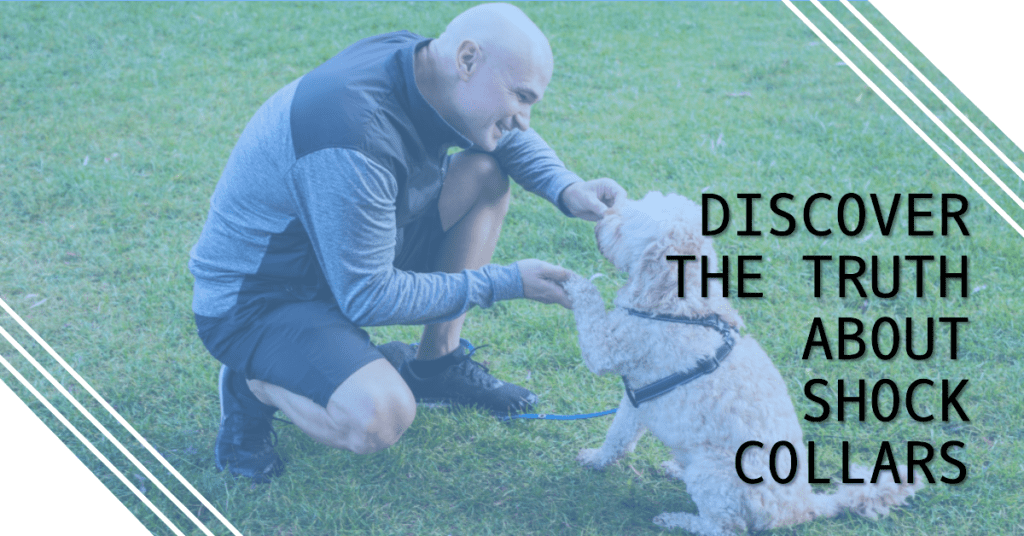As a professional dog trainer, I often get asked whether I use shock collars as a training tool. It's no secret that shock collars have become a controversial training tool in recent years, with some trainers swearing by them and others denouncing them as inhumane. In this article, we will dive into the topic of shock collars and explore their use by professional dog trainers.
Ever wondered, “do professional dog trainers use shock collars?” Join me as I unravel the facts about this controversial training tool in dog training.
The use of shock collars as a training tool is certainly controversial, with advocates and detractors on both sides of the debate. Some trainers swear by shock collars as a quick and effective way to correct undesired behaviors, while others argue that they cause unnecessary pain and can lead to a range of negative effects on the dog.
In this article, we'll examine the use of shock collars as a training tool, consider the arguments for and against their use, and explore alternative training methods that professional dog trainers employ to achieve effective results. Let's dive in.
Key Takeaways:
- Shock collars are a controversial training tool in the dog training community.
- Professional dog trainers have differing opinions on whether shock collars should be used.
- There are alternative training methods to shock collars that can be used to achieve effective results.
- The potential negative effects of shock collars on dog behavior, health, and welfare are a significant concern.
- It's important to consider all factors when deciding whether or not to use shock collars in dog training.
What Are Shock Remote Collars and How Do They Work?
As a training tool, shock collars, also known as e-collars, are devices that provide an aversive stimulus to dogs. This stimulus ranges from a mild electric shock to a vibration or a beep, which the animal experiences when it disobeys a command or engages in unwanted behavior.
Shock collars typically consist of a remote control and a collar, which goes around the dog's neck. When the remote control is activated, an electric current passes through metal contact points on the collar, emitting a shock that gets the dog's attention. The strength of the shock is adjustable, with most models offering several levels of intensity.
While shock collars may seem like an easy solution for obedience training, they are a controversial training tool. The aversive stimulation they provide has been known to cause anxiety, fear, and aggression in dogs, and their use is banned or regulated in some countries.
The Different Types of Shock / e-Collars
There are several types of shock collars available in the market:
- Remote training collars: These are the most common type of shock collars, with a range of up to 1,000 feet.
- Bark collars: These shock collars activate when the dog barks, rather than when a command is disobeyed.
- Boundary collars: These shock collars are designed to keep the dog within a designated area, such as a yard or a park.
- In-ground fence collars: These are also designed to keep the dog within a designated area, but they use an in-ground wire instead of a physical fence.
- GPS tracking collars: These collars use GPS technology to track the dog's location and provide a shock when it goes beyond a predetermined boundary.
The type of shock collar used will depend on the training goals and needs of the dog and its owner.
The Controversy Surrounding Using a Shock Collar in Dog Training


Shock collars, also known as electronic collars or e-collars, are a controversial training tool in the dog training world. Some trainers advocate for their use, arguing that they can be an effective way to correct undesirable behaviors. Others, however, believe that shock collars are inhumane, relying on negative reinforcement and potentially causing physical and psychological harm to dogs.
Positive reinforcement, on the other hand, is a humane training technique that rewards desirable behavior and encourages dogs to repeat it. This approach is widely considered to be more effective than negative reinforcement methods, including the use of shock collars.
Opponents of shock collars argue that they can cause anxiety, fear, and aggression in dogs, exacerbating behavioral problems rather than correcting them. The use of shock collars can also damage the bond between dogs and their owners, creating a stressful and negative environment for both.
Advocates of shock collars, however, point out that they can be an effective tool if used correctly. They believe that shock collars provide an aversive stimulus that can interrupt undesirable behavior and help dogs to learn appropriate responses.
Despite the controversy, it is important to note that many professional dog trainers do not use shock collars in their training programs. Instead, they rely on positive reinforcement and humane training techniques to achieve desired results.
Ultimately, the decision to use shock collars in dog training is a personal one that should be made after careful consideration of all the available information. If you are considering using a shock collar, it is important to seek advice from a qualified professional dog trainer who can help you evaluate the potential benefits and risks of this controversial training tool.
Alternative Training Methods to Dog Training Collars
As professional dog trainers, there are various training methods we use to help dogs learn and improve their behavior. While shock collars may be a popular choice for some, there are alternative training collars and techniques that rely on positive reinforcement and humane training practices.
Training Collars
Training collars are a popular alternative to shock collars. These collars work by applying pressure to the dog's neck when they pull on the leash or misbehave. There are several types of training collars, including:
| Type of Collar | Description |
|---|---|
| Remote Training Collars | These collars are used to reinforce good behavior and discourage bad behavior. The collar emits a tone or vibration to signal the dog instead of a shock. |
| Prong Collars | These collars have metal prongs that pinch the dog's neck when they pull on the leash. The prongs are not sharp and do not puncture the dog's skin. |
| Choke Chains | These collars tighten around the dog's neck when they pull on the leash. They are not recommended for inexperienced dog owners or for dogs with respiratory problems. |
Positive Reinforcement
Positive reinforcement is a humane training technique that uses rewards to encourage good behavior. Rewards can include treats, verbal praise, and physical affection. This technique has been proven to be effective in training dogs and helps to build a strong bond between the dog and trainer.
Insights from Professional Dog Trainers about Training System
As a professional dog trainer with years of experience, I have trained hundreds of dogs using various methods. In this section, I will provide insights into the use of shock collars by professional dog trainers. I will also discuss alternative training methods and the importance of experienced trainers in obedience training.
The Use of Shock Collars by Professional Dog Trainers
While some professional dog trainers may use shock collars as a training tool, many have moved away from this controversial method. Shock collars can have negative side effects on a dog's behavior and well-being, and experienced trainers understand the potential harm they can cause.
Experienced trainers know that every dog is unique and requires a personalized training plan. Shock collars can be deemed appropriate in certain situations, but positive reinforcement methods should always be the first approach.
Alternative Training Methods
Professional dog trainers use a variety of training methods that rely on positive reinforcement and humane practices. These methods include using training collars such as remote training collars, prong collars, and choke chains. However, these training collars should only be used under the guidance of experienced trainers and with care to avoid harm to the dog.
Training methods that focus on positive reinforcement, such as clicker training and reward-based training, are effective and humane. These methods build a positive relationship between the dog and trainer and create a happy, well-trained pup.
The Importance of Experienced Trainers
Experienced trainers have the knowledge and expertise to understand a dog's behavior and body language. They can recognize when a dog is uncomfortable or in distress, and adjust their training plan accordingly.
Experienced trainers also understand the importance of building a strong bond between the dog and trainer. They use positive reinforcement methods to create a positive training experience for the dog, building trust and respect between the two.
In conclusion, while shock collars may be used by some professional dog trainers, they are not the only method of dog training. Experienced trainers understand the potential harm they can cause and focus on positive reinforcement methods to create a happy, well-trained pup.
The Impact of Shock / e-Collar Training on Dogs
Electronic training collars, also known as shock collars, are a controversial tool used in dog training. While some trainers argue that they are effective, others have expressed concerns about their impact on dog behavior and well-being.
The use of shock collars can have negative effects on a dog's behavior and health. In some cases, these collars can cause physical and emotional harm to dogs. For example, frequent or prolonged use of shock collars can lead to anxiety, fear, and aggression in dogs. It can also result in physical injuries, such as burns and irritation on the dog's neck where the collar is placed.
Electronic collars are often used as a quick fix for behavior problems, such as barking, aggression, and disobedience. However, this method of training fails to address the root cause of the problem and can worsen the dog's behavior in the long run. Shock collars rely on punishment rather than positive reinforcement, which can be detrimental to a dog's overall behavior and training.
The use of shock collars raises ethical concerns about animal welfare and the humane treatment of dogs. Some experts argue that the use of aversive training methods can compromise the emotional and mental well-being of dogs and can lead to long-term negative effects on their behavior and health.
Studies have shown that positive reinforcement training methods, such as clicker training and reward-based training, are more effective and humane in addressing behavior problems and promoting good behavior in dogs. By rewarding desired behavior with treats, praise, and positive attention, trainers can create a positive and rewarding training environment that enhances the dog's learning experience.
Ultimately, the decision to use shock collars in dog training lies with individual trainers and their personal beliefs and training methods. However, as a professional dog trainer, I strongly advocate for the use of positive reinforcement methods that prioritize the dog's well-being, health, and happiness.
Conclusion – Train Your Dog Professionally
Throughout my research, I have discovered that while shock collars may be a popular training tool, they remain highly controversial. As professional dog trainers, it is our responsibility to consider all available options and choose training methods that are effective while also being humane and safe for our furry companions.
The Use of Shock Collars by Professional Dog Trainers
While some professional dog trainers may use shock collars as a training tool, many others have found success with alternative methods that rely on positive reinforcement. It is essential to note that there is no one-size-fits-all approach to dog training, and trainers should consider each dog's unique needs and temperament when deciding on a training method.
Effective Dog Training
Effective dog training is about building a positive and trusting relationship between a dog and their owner or trainer. It is crucial to understand that shock collars are not the only way to achieve obedience and good behavior in dogs. Positive reinforcement methods, such as clicker training and rewarding good behavior, can be just as effective, if not more so, than aversive techniques.
The Future of Dog Training
As the conversation surrounding the use of shock collars in dog training continues, it is clear that there is a growing demand for positive and humane training methods. As professional dog trainers, it is our responsibility to stay up to date with the latest research and training techniques to provide the best possible care for our furry clients.
Effective dog training is about creating a positive and safe environment for our beloved four-legged friends to learn and grow. By choosing training methods that prioritize the dog's well-being and welfare, we can help create happy and healthy relationships between dogs and their owners for years to come.
FAQ – Do Professional Dog Trainers Use Shock Collars
What are shock collars and how are they used in dog training?
Shock collars, also known as remote collars or electronic collars, are a type of training tool that delivers an electrical stimulus to the dog when activated by the handler. They are often used in dog training to teach or correct behaviors.
Do professional dog trainers use shock collars in their training programs?
While some professional dog trainers may use shock collars as part of their training program, the use of such aversive tools is a subject of debate in the dog training community. It's essential to note that not all trainers employ shock collars.
What is the stance of professional dog trainers on the use of shock collars?
Many professional dog trainers advocate for positive reinforcement and humane training methods, avoiding the use of shock collars or any aversive tools in their training approaches. They believe in building a strong bond with the dog through positive reinforcement techniques.
Are there alternative training tools that professional dog trainers use instead of shock collars?
Yes, there are various training aids and tools such as vibration collars, leashes, and reward-based training methods that professional dog trainers prefer to utilize in their training programs instead of shock collars.
What do pet dog trainers recommend as an effective training tool?
Pet dog trainers often recommend the use of positive reinforcement techniques and tools such as vibration collars or reward-based methods as an effective and
Do professional dog trainers use shock collars?
Yes, some professional dog trainers do use shock collars as a training tool. However, it is important to note that not all trainers utilize this method, and there is ongoing debate surrounding its effectiveness and ethical implications.
What is the controversy surrounding shock collars in dog training?
The use of shock collars in dog training is a controversial topic. Some argue that these collars can be effective in modifying behavior, while others believe they are inhumane and can have negative impacts on a dog's well-being. The debate centers around the use of aversive techniques versus positive reinforcement methods.
Are there alternative training collars to shock collars?
Yes, there are alternative training methods that professional dog trainers use instead of shock collars. These may include using training collars such as prong collars or choke chains, or utilizing positive reinforcement techniques that focus on rewarding desired behaviors rather than punishing unwanted ones.
What do professional dog trainers say about shock collars?
Professional dog trainers have varying opinions on the use of shock collars. Some trainers believe they can be effective when used properly and in specific situations, such as obedience training for working dogs. However, others prefer to rely on positive reinforcement methods and consider shock collars to be unnecessary or potentially harmful.
What is the impact of shock collar training on dogs?
The impact of shock collar training on dogs is a subject of concern. While some studies suggest that these collars can effectively modify behavior, there are also concerns about the potential negative effects on a dog's health, behavior, and overall welfare. The long-term impact of electronic training collars is still being researched and debated.
What is the conclusion regarding the use of shock collars by professional dog trainers?
The use of shock collars by professional dog trainers is a complex and contentious issue. While some trainers find them to be a valuable tool in certain circumstances, there is no consensus on their overall effectiveness or ethical implications. It is important for dog owners to carefully consider alternative training methods and consult with experienced trainers to determine the best approach for their individual pet.





